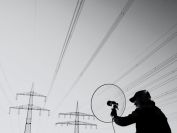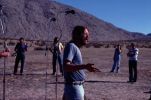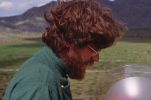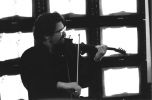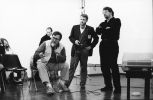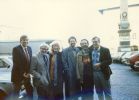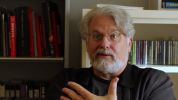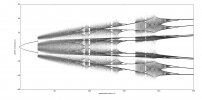The compositions, texts, and tools of the musician and sound artist David Dunn grow from interconnection of different cultural contexts and draw on a wide range of mindsets. The main framework consists of questioning what is the nature and interrelationships of “meaning,” “consciousness” and “mind.”
In various texts Dunn has published over last twenty years, he often relates to questions, already mentioned in this 1996 interview: how are music, consciousness and mind interrelated? Isn’t the concept of music and language as a phenomenon of an exclusively human world a mistake? Can sound, listening, and the liberation of the medium of sound trigger a transformation of our social and spiritual settings? Can sound be understood as an integral part of the “ecology of the mind”? Can sound and music change something in western culture, where there are many metaphors for reality that refer back to vision?
René van Peer: David, over the years you have written and recorded a set of compositions in which the music is intended to work as an intermediary between humans and their environment. What got you interested in this?
David Dunn: I think it began as a fairly naive fascination with sound. Even as a child I was very interested in natural history, interested in the behaviours of living things. Growing up in southern California I spent a great deal of time being in the nature and wilderness environment there. So there was certainly an innate interest, but part of it just had to do with an intuitive sense of fascination for sound as it existed in an outdoor environment. So one of the first projects that I actually succeeded in doing when I was 19 years old, was Nexus where I took three trumpet players into the Grand Canyon. And there the interest was, as I say, a fairly naive one, which was more just being interested in the result of the reverberations that existed in the canyon itself. The trumpets were set up to be sound activators of that acoustic environment. But over the course of being down inside that canyon for three or four days, there was an event that occurred which was quite unexpected — at least on my part. The trumpet players perched very far apart from each other, playing and hearing these reverberant structures within this immense open space. Three ravens flew over. We hadn’t seen any ravens during the previous days that we had been there. And then they appear as soon as the trumpets start playing, and they begin to fly in front of the trumpet players, doing barrel rolls, all these sort of aerial acrobatics. And cawing in and out of the trumpets, matching the pitches with the trumpets. It was very unexpected and very dramatic. And it basically set in my mind the question, what was going on here. This was not what I expected, and this was certainly not the intention of this as a composition. It was something more spectacular and interesting from what my intention was than I ever had imagined. The question began to rise in my mind that I was proceeding with an assumption that the environment was somehow this fabulous signal processor, this thing that could modify sound and produce new sounds – and what resulted was evidence of an intentionality for communication that could exist with the living environment, the natural environment. And that shifted my focus. It was more to answer the question as to what was really going on there beyond my expectations, that I began to focus on for the next fifteen years. It became a major point of focus in my work.
In what way did you pursue it in the various compositions that followed?
Starting first with the idea of specific interaction with another species, that was one of the next major works. There were a number of other works that also dealt with acoustic resonance and similar kinds of ideas – and again it is this quality of sound in an open environment as opposed to an interior environment. But the next major work that really began to address that question was a work called Mimus Polyglottos. There the idea was to focus on that property of sound making and to provide some kind of evidence that the composition of the music that would arise is not something that’s grafted on to the circumstances, but rather something that would emerge from the interaction that actually is occurring in the environment. And the focus was on one particular species, and that’s the Mockingbird. The name of the piece is that Latin name of the species. They are probably the most spectacular mimicking bird in North America. What they are most noted for is their ability to imitate mechanical sounds. I’ve heard them make the sounds of washing machine motors that were broken, or the sound of a Volkswagen engine that needed a valve job. Sounds like that. In addition to how they would imitate all these spectacular sounds of other birds. I used to live in a place in San Diego called Florida Canyon, at one end of this large canyon in the center of the city; and at the other end of this canyon is the San Diego zoo. I remember one morning being awakened by the sound of monkeys in my backyard, and thinking, “oh my god, monkeys have escaped from the zoo,” when in fact it was the Mockingbirds who travel up and down this canyon. They would learn to make these monkey sounds, and just carry them back and forth all the time, in addition to sounds from other animals in the zoo. What really got me interested in that was to focus on the possibility of this interaction, and to use the idea of sound (as it’s constituted in music) as a modelling for this kind of interaction in order to provide evidence of the actual intelligence of the bird. Rather than trying to exploit the sounds of the bird, I was interested in trying to challenge the bird’s ability to actually mimic these sounds that are so foreign to its environment. Even though Mockingbirds have been extensively studied, there still is not a convincing theory as to why they mimic other bird calls to the extent that they do. It’s quite spectacular, they go through cycles of all the different birds. You can basically hear almost all the repertory of other birds in North America occurring in Mockingbird songs. So the idea was to really try to challenge it in the natural environment. Going out rather than having captive birds. Go out into the environment and try to get them to interact with and imitate sounds that were completely foreign and probably completely novel, that they hadn’t been exposed to – and see what would happen. And the result was quite spectacular, because the sounds were electronically produced square waves, which are about as unnatural to our ears, almost as aggressive and mechanical a sound as is imaginable. And I would go out at night, like three o’clock in the morning, during their mating season. The males will sit in trees and remain stationary all night, and sing the entire night. I set up a loudspeaker, played back a tape. It was a pre-recorded tape, because I didn’t want to be accused of reacting to the bird. I wanted to see what the bird’s reaction would be to the stimulus. There were certain attributes to the tape which were ratios of sound to silence that were somewhat imitative of the kinds of ratios of sound to silence that the Mockingbird’s song has. It was also created in such a way that it was within the frequency spectrum that Mockingbirds generally exhibit. Besides that it was something absolutely foreign. It was all these frequency and amplitude modulated square waves. We played it to the bird, and instantly the bird would start to imitate and match pitches – but beyond that would start to what really appears to be some form of improvisation around this other sound source. From that point rather than concentrating on a single species, the idea of mind in nature is what really captivated me. My interest in a lot of that work was less about notions of music per se, or creating music, than it was with using music as a model for providing evidence for minded systems in the natural environment. I was interested in it as an occasion to give rise to that.
You mean that a mind in the environment would express itself sonically?
Exactly. And that’s I think where my work parts company with a lot of the major thrust of experimental music that has been concerned with the acquisition of nature sounds (bird calls or whatever). The lineage that extends in experimental composition through Cage, which is this idea that the sounds are a potential resource for the composer. And when it comes down to it I don’t have a great argument about that, as something negative. I think the argument is fairly sound. Except I think the tendency in Cage’s work, and a lot of people who followed him, was that a result of that thinking is to decontextualize the sounds. And my interest has been in _re_contextualizing the sounds in a serious interactive manner, to go back into the environment itself in a way and to try and establish these systems for providing evidence that these sounds are not just materials to be available to human musicians. These sounds are the evidence of purposeful minded systems of communication. These things have an integrity that is part of a huge fabric of life. And while they may be interesting, and while they may be useful in terms of expanding our concepts of musicality and the materials of music, I think there is something more profound that needs to be examined. And it’s precisely this idea of communication and how to recontextualize our understanding.
The fact that you use the word communication can suggest that what you’re doing is establishing something that you might call language. Is that correct?
Yes. One of the major models is not so much looking at human linguistic structure per se, but rather at the idea that music has been a kind of conserving strategy for ways of communicating that are related to human linguistic structure. The characteristics of those things that we call music as a human activity throughout the trajectory of our species, has been one that is closer to how other forms of life may communicate. In some sense I believe that music has been a way of conserving just that way of interacting with our world. When you look at what we call music of most of the indigenous peoples in the world (they may not call that music, but we do, from a western perspective) I think that exhibits a lot of those characteristics. And that has been the predominant mode for what music represented. Certainly it is about social interaction, but it is about social interaction in an environmental context.
Where humans place themselves in an environment, communicate with it, and are part of it, rather than stand apart and (as some sound recordists seem to do) pretend that they’re not there.
That’s right, and I want to totally up front about that. My work is entirely about making it absolutely clear that my presence is part of that. I can’t remove myself from that process of observation. What I am trying to do is create interactive situations which encode the process of observation as part of the interaction, and make that self-evident.
When you talk about the mind of an environment, do you mean by that the very species that are in that environment, that call together, and that together constitute something that has an organisation to it, a kind of arrangement?
Absolutely. I think the clearest articulation of that is, again looking at indigenous peoples, the Pygmees of the rain forest in Central Africa very explicitly talk about the forest itself as ‘Mother’, as generative source. And music is a means by which they give back and communicate to the totality of that mind. In the daily circumstances of their life they are surrounded with a web, a fabric of sound which is constantly the voice of that mother, of that generative nurturing source. When they make music it is to match the level of that. Music is about matching the fabric that speaks to them on a daily basis. Most of human music making throughout our history has been outdoors. It hasn’t been made in interior spaces – in homes or cathedrals, all that is a very recent circumstance. We may believe that we are somehow divorced from that generative source in that we move indoors and the process of being divorced from that. But then what we attribute as characteristics to the meaning of music I think has to do with conserving that original intention. Most of when we talk about spiritual aspects of music, or we use it for those purposes, what we are really doing is just trying to re-stimulate, or try to find some recapitulation to these other levels of music as a communicative source with the living world.
In what way would you yourself, as a composer, as somebody who puts together sounds, try to arrive at a language or a format to make this communication happen?
Well, that specifically involves a shift in the understanding of how we exactly talk about our model language. Most of the traditional notion of language has been a cybernetic one of input/output modes of communication, that somehow were these processing boxes in which signals come in and go out, and that there is an objective characfteristic to language. I don’t think that’s true. I think laguage speaks us. Rather than us speaking language. We swim in this soup of language, that is an entire heritage of our species, that we share of course with everything that makes sound. That soup is constantly in us and we move through it. We give voice to it. But it’s not something that is objective in that sense. It’s not a thing that has a fixed meaning. There is no such thing I think as a fixed meaning. We’re always in a process of dialogue that gives rise to meaning. And that’s constantly a dynamical process. In that sense when I talk about environmental language I am really talking about something that has to rise from an interactive circumstance. It’s an emergent property. One of the most profound insights of scientific thinking in the latter 20th century is this concept of emergent properties, that there are these complexities which arise from apparently simple modes of interactions. And they transcend the structures of what we would expect to be present by these interactions, and something much more complex arises. Just as life is probably an emergent property. Language is an emergent property – this dance that we’re engaged in interactively with the world on a constant basis.
To set the record straight, when you use the word interaction, you mean something different than what people make it mean in computer related contexts.
Oh, absolutely. I think that’s a complete misnomer as it’s used in computer culture. I have yet to see any single instance of something that I would call interactive. All that we are generrally referring to in our computer, no matter how elegant or sophisticated or apparently complex the programme is – it doesn’t give rise to something that’s interactive. It’s basically a constrained reality. It’s a box with limits imposed, that we can move within and have some sort of apparent free will, but it’s highly constrained, and highly contrived. And that is not interactivity. What I mean by interactivity is that which takes place between living systems. And again there’s an occasion for something highly unpredictable and highly complex, that can arise from these circumstances.
And you have enough experience with computers, using them in music and everything, to be able to say that?
Well, I am definitely not a Luddite, who is anti-technology. I use it constantly. An aspect of my work is to use these technologies in a way that they make these issues more problematic rather than simplifying them. I am very interested in the apparent contradiction of using hi-tech tools in a natural environment – for a basic reason. Most of what we live in now is a technological environment. That’s the status quo. That’s the social ground which constrains us. The degree to which we understand these tools, is the degree to which we have freedom from them. If we don’t understand them, and don’t know how they work and ascribe to them some mystical significance that the machines are doing our thinking for us… I basically think they are trivial. But no more or less trivial than other forms of tools.
To get back to this idea of communication within environments, do you have examples of that in other compositions, how that works?
The chronological progression of a lot of this work gets very problematic. My focus began to move away from the singularity of interactions with a single species to the idea of these complex interactions where mind is seen as an emergent property of a large ecosystem or a habitat rather than just the interaction with a single species or a single member of another species. The evidence for that is what is encoded in the sounds themselves. The shift of interest began when I started to realise that what we call music is, again, the actual presence of music itself, the sonic fabric which does emerge is itself the evidence of this mindedness – and that’s where I began to focus, rather than just on something that, while interesting, was not at the same level of complexity. So I began to set up these circumstances for interaction which would involve very large open areas and multiple species and multiple situations to give rise to something where it’s… it’s almost a kind of chemical process… it’s something that has precedence, even in terms of the language to describe it, in other belief systems that are also very archaic. The idea of “intellechees”, or of the spirit of place – again I think the spirit of place is something that arises.i The mind of a place is something that arises from the complex interactions of the things that live there. What my focus then became is to provide evidence for that by participating in the location over a longer period of time, and trying to set up things that were more cyclic in the interaction. Much of this work does not sound musical per se to the average listener, and it wasn’t conceived musically. But what is eveident is the complexity that arises. And that complexity has an integrity which is undeniable.
Can you give examples of that in pieces that you did?
There’s one project called Entrainments 1, where I simply started out by playing an oscillator in a place, in a forest location. Not very loud. Most of my work has not been about loud sound, because you don’t really need loud sounds. It’s about providing a stimulus often which is completely foreign to the location, beginning from that. Beginning with something that is in some sense an intrusion, but not an immensely destructive intrusion, allowing time to see what will happen in terms of this intrusion. Documenting that, and then building upon the response that may occur. So in the case of Entrainments 1 _I simply sat in a location, played a single sine-wave oscillator, where I was manipulating it, trying to hear – optimizing the acoustical resonance of the location, how this oscillator would sound. It was just a very simplistic procedure, where frequency was being changed over an hour’s time. Twenty minutes into doing this suddenly a Blue Jay came and flew literally within a foot of my face, looking at me, and started to scold me. _(laughing) It was very aggressive and very focused, I assume with regard to the sound that was being made. All this was documented in an audio recording. And then the next procedure was to build upon that in various levels over time, where I then took that recording, which included the Blue Jay and the oscillations, and kept feeding that back into the location and then doing subsequent re-recordings over time. Each layer became a document of the changes that accrued to that. The project also involved another level, where I took a friend who is a poet and had her sit in that location. With a stream of consciousness she described that place, as another level where human consciousness, transmuted into language, becomes part of that. Where the psychological process becomes an encoding of observation and meaning at that level. All these things were over time mixed at various levels, and repeated back. It took several months to do this piece, to just build up these layers. By the end it began to function as a chaotic attractor, this basin of attraction to the wildlife that existed there. Rather than being repelled they were being attracted and almost every time I’d add a layer I’d see these wonderful phenomena of huge numbers of birds flying into the location and hovering above it, just listening. The interactions became something that was not all that apparent necessarily by the final recording. But over the period of time provided me an occasion to see something I never expected. The other level is how we assume these technologies to be unnatural, when in fact the natural world, other forms of life find them as fascinating as we do, possibly. Maybe because of their exotic quality, or because it is so foreign. And these are things that I do not necessarily understand. They are just things that I observed. I don’t ascribe to them some sort of mystical quality, or pseudo-spirituality. This work is just a very didactic process, to see the transformations and changes that occur. I don’t think there is something strictly special about this. It is part of what humans have always done. And it’s part of the heritage of what we have called music, and it’s something that we have just in a fairly late period of time in our evolution have gotten somewhat removed from. I don’t make claims for this as being something extraordinary. In fact I am making claims for it as something highly ordinary.
Do you still make such pieces?
I haven’t for several years, actually. I planned at some point to go back to that, but the frustrations I began to feel were twofold. First of all I was only interested in trying to push these things, so that each piece became a kind of progression of focusing on these issues. I see no point in repeating the same kinds of things over and over again. I basically took it at that time about as far as I could. The next step necessitated both a greater sensitivity in myself, greater knowledge in terms of what I was observing, and in terms of my need to understand what I was observing. This involved my moving in the direction more of looking at human language and how consciousness is encoded in terms of that, and what that means. That has been my work in the more recent years, and that is a kind of preparation for taking the previous work to another level. I felt the need to do that. The second level was a greater refinement in the nature of the tools themselves and the technologies that I was using. At some point I stopped being interested in using things like traditional musical instruments. While there is a tremendous elegance and beauty to the acoustical characteristics of human musical instruments, there was something that just felt so contrived about having a clarinet or a trumpet being placed into this circumstance. Even though they are quite convenient, and there is a certain facility available in terms of skill of sound making that a good instrumentalist would bring to that, the level of contrivances became too jarring for me. The latter works only involved maybe human voice, and not even necessarily singing, but simply speech – language itself as the material as an interface to that, as a pathway to interaction; and electronic sounds, for the speed of processing that could occur, but I was more interested in trying to use what was there in the environment. That began to move in the direction of the last project that was called Sonic Mirror, with the idea that these technologies could afford a level of macro self-reference to the environment itself.ii That became the primary interest. After going through several major attempts at refining those technologies I began to feel that technology had not reached the point that I needed it to be. Then rather than pretend that it was I have simply chosen to wait until the technology will have evolved to a point where it’s more appropriate to be put back into that same function. And it still is not at that point yet, at least to my satisfaction. But I think it will be. And at that point I will probably continue with that work. But when I do I will also have another level of understanding, because of the work that I have been doing with language.iii
Have you done other work in relation to natural environments?
Parallel to this I always had an interest in sound recording. I have worked off and on my whole life as a professional sound engineer and recordist. One of the things I have always been interested in is nature sound recording. But it was more the kind of relationship to it that photography would have to natural environment, and even though I have continued to do that, it was often simply a commercial activity for me also. It provided for me a way for staying alive and feeding myself and paying the rent. So I have done lots of that sort of work over the years, and I have very mixed feelings about that kind of work, for a number of reasons. First of all, we have a tendency to confuse the map for the territory. These kinds of recordings are often put forth as some sort of preservation action, when there’s nothing being preserved. We might be able to talk about preserving an ecosystem, because the things that are alive are still alive, and we’re trying to optimize the conditions for their survival. But when you’re making a sound recording, you’re not preserving anything except an illusion. Some sort of technological projection that’s a contrivance, that’s entirely a construction, and it’s no more real than if I was to make a drawing of that location. So there’s nothing being preserved. It’s a flattening out of the complexity of an acoustic environment. It’s just sounds that ultimately will be… it’s just energy patterns that have been put onto a storage medium, so that we can later make a loudspeaker cone move in space. That’s all it is. There is nothing being preserved. And I find it actually offensive when so much of this soundscape work makes these claims for environmental activism. I think it’s nonsense. In fact it often does the opposite. It actually misdirects people, away from the reality. And imposes this contrivance as if it were real. That’s the mixed feelings.
You made a guide for listening to natural environments. Is this the subject matter of that book?
Very much so. It was a two-edged thing. First of all, to try to talk about my own particular slant on what the actual sounds of nature mean, more as a strategy to sensitizeiv people to the process of hearing in life generally, to help focus on that. The other edge of that two-edged sword was to make it very clear that the recordings themselves are these contrivances. That they are not a substitute for the reality. And if one is really interested in preserving that reality then to get involved at a political level or join Earth First and do something about it, rather than think that by making these recordings they’re doing that, when in fact they’re not. And most of the times what you hear in these recordings is someone who sat long enough between periods of airplanes and cars passing that they can get something that appears to be a pristine recording. And that’s what’s rare. That’s almost a lie, to put that forth as the reality is almost a lie.
That example that you just gave of a person sitting there, putting up his microphone and recording a span of sound in between cars passing, that is part of another record that you made, where you tell that that is what you did.
Yes, I make that very upfront. And that is for a reason. By doing that I am actually exposing the reality that that’s as long as it may exist as a reality. And that particular CD, called the lion in which the spirits of the royal ancestors make their home, was a byproduct of a trip to Africa where I was on assignment to do waterhole habitat recordings for zoos. In the process of doing that I recorded a whole bunch of other kinds of sounds that to me were much more interesting than the so-called pure nature sounds. All the sounds on that CD are basically problematic. The piece was composed to put forth a veneer that would appear to be simply another set of nature soundscape recordings, when in reality, if you listen closely to all the sounds that are present there, every one of them is problematic. In the sense that they aren’t at all what you first think they are. For instance, there is the very beautiful sound of a waterhole in Zimbabwe, both at night and during the day, the next morning. There’s frogs and lions roaring, and all these things, and it appears to be the natural environment. If you listen very closely, what you hear is some water running, just a little thread of water running in the midst of the sound. And that thread of water is pumps. Kerosene driven pumps that bring water up from the aquifer in a game park. Without that pump, without that human technology, the estimate is that probably 80% of the wildlife would be dead in a year. Humans have so altered this so-called wilderness, circumscribed it with fences, and created the necessity for the technologies to be there as a maintenance action, to keep these things alive. Now what it really means is, what we’re listening to is a global park. We’re not listening to wilderness, and we’re not listening to something natural at all – this so-called nature. We’re listening to something where animals are in a very large zoo, but it’s still a kind of zoo. The contradictions are rife, and it’s those kinds of contradictions that really began to interest me from a sound recording standpoint. Rather than trying to record something as a pure environment that long ago ceased to exist, and then putting that forth and pretending like that’s what it really is. My interest has been the opposite, to use the recording vehicle to articulate the contradictions themselves.
There’s also human singing on that record. Both the natural habitats and the cultural environments that are on this CD have this idea of not being pristine, of being in a phase of change, which is somehow in contradiction with one of these tenets that was always present in ethnography or anthropology that you could freeze a culture and describe it in that way, whereas a culture and a natural environment will always be in states of change.
Will always be in states of transition, and in order even to be alive they have to be involved in dynamical processes of change. So, what that CD was really about was documenting something about the processes of change, rather than illusions about what African society is, or what African environments are. That it’s much more complex than we ever thought. Somehow the West, the First World, looks at the Third World and thinks that these things all need to be preserved. When in fact what I think is really happening is that the entire world changes constantly, and that the Third World is going through a level of change – which is probably the place we should be looking for as where our cultural change will be at some point in the future. So these contradictions are actually ways of looking at something that we will have to experience ourselves.
Such as? Can you explain that?
I’m not sure if I can, really. Except on the level of, for instance in Zimbabwe, there is an assumption about the nature of African religion as pagan belief systems and spirit beliefs. And my experience was that this… one of the things on the recording was in fact this glossolalia, speaking in tongues, among the Kalonga people in Western Zimbabwe. It was a very dramatic circumstance where you hear the singing and people were going into trance and speaking in tongues. But what it really is is that they’re Pentecostal Christian groups, out in the middle of the savannah, and what you are listening to would appear to be something very pagan, but in reality it is a Christian church. Now albeit when you penetrate that deeper, then you begin to see where for them the African religion still really is predominant, even though they call themselves Christians, that the idea of the Holy Spirit is just one more spirit form which has been absorbed into a pantheon of intelligences that constitute fairly traditional African religion. Those sorts of plays, culturally, and the kinds of things that go on in Zimbabwe politically—this is a socialist government, where they won their war for independence fairly recently, in the 1980s. There’s the assumption again, that this is socialism and the West versus traditional African beliefs. Well, there’s a brilliant book by an ethnographer David Lan, who was born in South Africa and lives in England. He wrote a book called Guns and Rain. And what _Guns and Rain _is about, is the role of spirit mediums in the war for independence in Zimbabwe. It turns out that one of the most important circumstances in that war was the role played by the traditional African spirit mediums, who went into trance and would speak as mediums to their ancestors who had fought the previous, failed war for independence. And all of this was so intense and so successful that the white Rhodesian government had hitmaps, outlining where all the spirit mediums were. Because the spirit mediums were able to predict troop movements of the Rhodesian army so successfully that they became the central focus of the war. How do you shut these people up? And the book outlines some extraordinary transformations of black African men who were fighting in the rebel forces, who had lived their whole lives in Livingstone, and then because of the war were out in the bush for years at a time and had incredible conversions and visitations from the traditional spirit forces, where they reverted back to their traditional religion. Not out of some allegiance to traditional tribal beliefs, but just the opposite. Because of a war for independence against the white government, against the colonial government, they are suddenly in the circumstance where they’re back in the bush again. And the bush is the source of experience and information that is so compelling beyond anything they’ve been prepared for by an urban lifestyle. They came into communication with it, and that was one of the major forces of the war. One of the major energy forces or trajectories of how the war unfolded was the influence of these things. What I am really focusing on there is not some Romantic notion about traditional African religion or about its environment, but rather about the extraordinary complexity of cultural interactions and collision, and how we define the environment in terms of that. That has traditional aspects, but it has things which are completely unpredictable. And what currently Africa is, is something that I don’t think we understand in the West. It’s something of such extraordinary complexity that our assumptions and our Romantic views just are not operable anymore. And that’s what I find interesting.v
You said that we should look at those places to see where we may be going.
Well, I think it’s that process of extraordinary cultural turmoil, where things are not defined through easy assumptions. It’s how the people adjust and how they go about surviving in terms of that, which might provide us with clues that we need to know. Both in terms of our relationship to the environment and in terms of social change that almost seems to be inevitable at this point.vi
This interview with the Dutch music journalist René van Peerem appeared in 1996, while van Peer was creating a series of interviews with American composers devoted to the relationships between their works and the natural environment. It was republished in 2000 in Leonardo Music Journal #9.
We thank David Dunn and René van Peer for their kind permission to translate and republish the text.
Notes
Nexus 1: Music, Language and Environment: Environmental Sound Works by David Dunn, 1973–1985, Innova Recordings (1996).
David Dunn: Music, Language and Environment (CD, January 1996).
Why Do Whales and Children Sing? (Book/CD), EarthEar, 1999.
David Lan, Guns and Rain: Guerrillas & Spirit Mediums in Zimbabwe, University of California Press, 1985.
